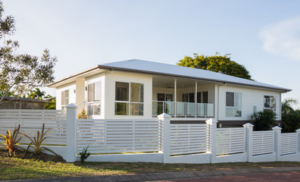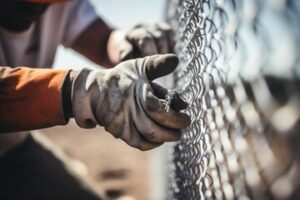Fence Company Summerville SC offers a variety of benefits, including privacy, security, and curb appeal. Before you build a home fence, check with your municipality about regulations and property lines.
Your town may require a building permit, and you should also call your local utility departments to mark any underground lines before digging holes for posts. Next, review your design goals to choose the right type of fence.

Different yards, family needs and budgets call for different fence ideas. For instance, you may need a pool fence to keep children and pets safe or a backyard barrier to keep critters out of the garden. Others are more interested in privacy or a way to frame their yard or add curb appeal. Fence material choices will also have a huge impact on how the fence looks and function.
For example, wood fences come in a variety of styles and price ranges, including affordable pallet fences made from slats of leftover or scrap lumber that are tied together to create panels. These fences offer privacy at a fraction of the cost of high-end cedar. Other common wooden fences include stockade and shadowbox fences, which are built with boards positioned on opposite sides of the central rail to provide equal screening from both the front and back of the property.
A wrought iron or chain link fence is another option for creating a more decorative fence that offers intermediate levels of privacy and security. These fences often feature a gate for entry and exit from the property and can be fitted with a lock to secure your home. A lattice fence constructed from open criss-crossing slats is another option for adding style to a solid privacy fence. These types of fences don’t offer complete privacy, but they can be fitted with climbing vines to increase their level of coverage over time.
When it comes to deciding how tall to build your fencing, you should be mindful of municipal height restrictions as well as homeowners association rules. Many cities allow a maximum of six feet for privacy fences and may require planning permission beyond that point. You should also consider the climate of your area when choosing materials. For example, an arid or wet climate can accelerate the rate at which wood deteriorates.
Home and business fences are more than just visual deterrents to crime; they also help keep family members safe from animals and wild intruders. Fences can keep children and pets from escaping the yard, and can protect pools and hot tubs from unauthorized entry or theft. And if you have expensive landscaping or other valuables on your property, fences can help prevent them from being stolen or vandalized.
When selecting a security fence, look for one that is tall enough to be difficult to climb but not so high that it could provide a hiding place for burglars. You should also choose a material that is durable, sturdy, and designed to resist attempts to break in. Metal, wrought iron, chain-link, and welded wire fences are all good choices for security fencing, as they are often built thicker than other fence types. They are also hard to break through or push over. Fences that have close-together vertical bars and are topped with barbed wire or spikes are also excellent security options.
If you choose a wood fence, stain it with a protective sealant. This helps prevent warping, wood rot, and fading. You should apply a sealant or stain to your fence every two or three years.
In addition to a fence, there are a few other things you can do to enhance your home’s or business’s security. For instance, install motion-sensor lighting outside your home, and remove shrubbery that might provide criminals with cover. It’s also a good idea to get to know your neighbors and start a neighborhood watch program.
When it comes to securing your home and business, you want to work with a professional contractor that is licensed, insured, and bonded. Ask potential contractors for product samples, a written contract, and references. You can find qualified contractors by using the Find a Contractor tool on the American Fence Association website. You should also check with your city for any zoning or permit requirements. Also, it’s important to do a thorough inspection of your fence before making a final decision. Ideally, you should walk the entire perimeter of your fence at least once a week to identify any issues that might compromise security.
A home’s curb appeal is the first impression a potential buyer makes when viewing the property from the street. This includes the exterior of the house, landscaping, and driveway. In real estate, a first impression can be the difference between a sale and a home that sits on the market for months. While a buyer’s primary focus may be on the interior of the home, it is important to give the property the best appearance possible. Having a great first impression can attract buyers and increase the sales price of your home.
As property values continue to decline, homeowners are focusing on home improvements that will add value to their homes. While remodeling the kitchen, converting a basement into a bedroom, and installing a pool are all great projects that will add value to your home, the easiest and most affordable way to add value is to boost your curb appeal.
A home with good curb appeal is a major selling point in any market. Many of the elements that create curb appeal are relatively inexpensive and do-it-yourself projects that can be done in a weekend. Adding new paint to the outside of your home and tidying up the landscape will instantly improve the look of your property. New mailboxes and light fixtures can also make a big difference in the way your home looks.
Adding garden features such as arbors, trellis, and short sections of decorative fence panels will enhance your garden. These garden features can be purchased in easy-to-build kits or prefabricated sections that simply connect together. Adding weather-resistant outdoor art, such as birdbaths, metal cutouts, or sculptures will add a touch of whimsy to your yard. Planting flowers that bloom throughout the season will give your property a fresh, welcoming appearance.
Hiring a professional to do curb appeal enhancements can be expensive, but they can help you sell your home at a higher price. As lot sizes decrease, it is increasingly important to maximize every inch of your yard. Adding the right home accents, including a garden or patio furniture and attractive lighting, will make your home feel inviting and appealing to potential buyers.
Your home fence serves several functions, and it needs to be maintained regularly. It needs to be cleaned to remove dirt, grime and mildew buildup. It also requires regular staining to protect the wood from moisture and UV rays. It is important to choose a color and stain that suits your home and yard. Staining your home fence can also extend its lifespan and reduce the risk of rot or mold growth.
Wooden fences require a thorough cleaning prior to staining. It is best to use a pressure washer that will blast away any grime and expose a clean layer of wood for staining. A mixture of water and vinegar can also be used to remove stubborn stains. Once the fence is completely dry it can be stained using a brush, roller or spray rig. The wood should be sealed once it is fully dry, and it will need to be resealed after every few years.
If you have vinyl or PVC fencing, you will need to scrub it with a mild detergent and hose it down. It is a good idea to scrub it with a wire brush to get into any tight spots. A silicone-based lubricant can also be applied to hinges and other moving parts of your fence to prevent rust and keep them functioning smoothly.
It is also important to inspect your fence for any signs of damage, especially after a rainy period. Check for any rotting or weakened areas in the posts, and replace any sections that have been damaged. It is also a good idea to check for loose boards that can be easily repaired with a waterproof wood glue.
Plants and vines that are allowed to overtake your fence can exert too much pressure on the wall, which could cause structural damage. It is a good idea to trim any trees or plants that grow into or over your fence, and keep shrubs trimmed back so they don’t rub against or grow through the wall. Regularly clear away winter debris such as leaves, twigs and acorns to minimize the accumulation of moisture that can accelerate rot.
